Using Historical Archives and Landsat Imagery to Explore Changes in the Mangrove Cover of Peninsular Malaysia between 1853 and 2018
Abstract
:1. Introduction
2. Materials and Methods
2.1. Study Area
2.2. Data Collection and Analysis
2.2.1. Historical Data
2.2.2. Remote Sensing Data
3. Results
3.1. Retrospective Information to Study Historical Mangrove Extent in Peninsular Malaysia
3.2. Remote Sensing to Determine the Mangrove Area in Peninsular Malaysia
4. Discussion
4.1. Use of Historical Information to Understand Mangrove System in Peninsular Malaysia
4.2. Dynamics of the Mangrove System in Peninsular Malaysia
5. Conclusions
Supplementary Materials
Author Contributions
Funding
Data Availability Statement
Acknowledgments
Conflicts of Interest
References
- Donato, D.C.; Kauffman, J.B.; Murdiyarso, D.; Kurnianto, S.; Stidham, M.; Kanninen, M. Mangroves among the most carbon-rich forests in the tropics. Nat. Geosci. 2011, 4, 293–297. [Google Scholar] [CrossRef]
- Alongi, D.M. Carbon cycling and storage in mangrove forests. Ann. Rev. Mar. Sci. 2014, 6, 195–219. [Google Scholar] [CrossRef] [PubMed]
- Dahdouh-Guebas, F.; Hugé, J.; Abuchahla, G.M.O.; Cannicci, S.; Jayatissa, L.P.; Kairo, J.G.; Kodikara Arachchilage, S.; Koedam, N.; Mafaziya Nijamdeen, T.W.G.F.; Mukherjee, N.; et al. Reconciling nature, people and policy in the mangrove social-ecological system through the adaptive cycle heuristic. Estuar. Coast. Shelf Sci. 2021, 248, 106942. [Google Scholar] [CrossRef]
- Dahdouh-Guebas, F.; Mathenge, C.; Kairo, J.G.; Koedam, N. Utilization of mangrove wood products around Mida Creek “Kenya” amongst subsistence and commercial users. Econ. Bot. 2000, 54, 513–527. [Google Scholar] [CrossRef]
- Walters, B.B. Patterns of local wood use and cutting of Philippine mangrove forests. Econ. Bot. 2005, 59, 66–76. [Google Scholar] [CrossRef]
- Jayatissa, L.P.; Hettiarachi, S.; Dahdouh-Guebas, F. An attempt to recover economic losses from decadal changes in two lagoon systems of Sri Lanka through a newly patented mangrove product. Environ. Dev. Sustain. 2006, 8, 585–595. [Google Scholar] [CrossRef] [Green Version]
- Aye, W.N.; Wen, Y.; Marin, K.; Thapa, S.; Tun, A.W. Contribution of mangrove forest to the livelihood of local communities in Ayeyarwaddy Region, Myanmar. Forests 2019, 10, 414. [Google Scholar] [CrossRef] [Green Version]
- Lee, S.Y.; Primavera, J.H.; Dahdouh-Guebas, F.; Mckee, K.; Bosire, J.O.; Cannicci, S.; Diele, K.; Fromard, F.; Koedam, N.; Marchand, C.; et al. Ecological role and services of tropical mangrove ecosystems: A reassessment. Glob. Ecol. Biogeogr. 2014, 23, 726–743. [Google Scholar] [CrossRef]
- Dasgupta, S.; Islam, M.S.; Huq, M.; Khan, Z.H.; Hasib, M.R. Quantifying the protective capacity of mangroves from storm surges in coastal Bangladesh. PLoS ONE 2019, 14, e0214079. [Google Scholar] [CrossRef]
- Hochard, J.P.; Hamilton, S.; Barbier, E.B. Mangroves shelter coastal economic activity from cyclones. Proc. Natl. Acad. Sci. USA 2019, 116, 12232–12237. [Google Scholar] [CrossRef] [Green Version]
- Nagelkerken, I.; Faunce, C.H. What makes mangroves attractive to fish? Use of artificial units to test the influence of water depth, cross-shelf location, and presence of root structure. Estuar. Coast. Shelf Sci. 2008, 79, 559–565. [Google Scholar] [CrossRef]
- Serafy, J.E.; Shideler, G.S.; Araújo, R.J.; Nagelkerken, I. Mangroves enhance reef fish abundance at the Caribbean regional scale. PLoS ONE 2015, 10, e0142022. [Google Scholar] [CrossRef] [Green Version]
- Glazner, R.; Blennau, J.; Armitage, A.R. Mangroves alter predator-prey interactions by enhancing prey refuge value in a mangrove-marsh ecotone. J. Exp. Mar. Biol. Ecol. 2020, 526, 151336. [Google Scholar] [CrossRef]
- Avau, J.; Cunha-Lignon, M.; De Myttenaere, B.; Godart, M.-F.; Dahdouh-Guebas, F. The commercial images promoting Caribbean mangroves to tourists: Case studies in Jamaica, Guadeloupe and Martinique. J. Coast. Res. 2011, 64, 1277–1281. [Google Scholar]
- Satyanarayana, B.; Bhanderi, P.; Debry, M.; Maniatis, D.; Foré, F.; Badgie, D.; Jammeh, K.; Vanwing, T.; Farcy, C.; Koedam, N.; et al. A socio-ecological assessment aiming at improved forest resource management and sustainable ecotourism development in the mangroves of Tanbi Wetland National Park, the Gambia, West Africa. Ambio 2012, 41, 513–526. [Google Scholar] [CrossRef]
- Spalding, M.; Parrett, C.L. Global patterns in mangrove recreation and tourism. Mar. Policy 2019, 110, 103540. [Google Scholar] [CrossRef]
- Richards, D.R.; Friess, D.A. Rates and drivers of mangrove deforestation in Southeast Asia, 2000–2012. Proc. Natl. Acad. Sci. USA 2016, 113, 344–349. [Google Scholar] [CrossRef] [Green Version]
- Thomas, N.; Lucas, R.; Bunting, P.; Hardy, A.; Rosenqvist, A.; Simard, M. Distribution and drivers of global mangrove forest change, 1996–2010. PLoS ONE 2017, 12, e0179302. [Google Scholar] [CrossRef] [PubMed] [Green Version]
- Goldberg, L.; Lagomasino, D.; Thomas, N.; Fatoyinbo, T. Global declines in human-driven mangrove loss. Glob. Change Biol. 2020, 26, 5844–5855. [Google Scholar] [CrossRef] [PubMed]
- Dahdouh-Guebas, F.; Ajonina, G.N.; Amir, A.A.; Andradi-Brown, D.A.; Aziz, I.; Balke, T.; Barbier, E.B.; Cannicci, S.; Cragg, S.M.; Cunha-Lignon, M.; et al. Public Perceptions of Mangrove Forests Matter for Their Conservation. Front. Mar. Sci. 2020, 7, 901. [Google Scholar] [CrossRef]
- Sulong, I.; Mohd-Lokman, H.; Mohd-Tarmizi, K.; Ismail, A. Mangrove Mapping Using Landsat Imagery and Aerial Photographs: Kemaman District, Terengganu, Malaysia. Environ. Dev. Sustain. 2002, 4, 135–152. [Google Scholar] [CrossRef]
- Azian, M.; Ismail Adnan, A.M.; Mohd Hasmadi, I. The use of remote sensing for monitoring spatial and temporal changes in mangrove management. Malaysian For. 2009, 72, 15–22. [Google Scholar]
- Kanniah, K.D.; Sheikhi, A.; Cracknell, A.P.; Goh, H.C.; Tan, K.P.; Ho, C.S.; Rasli, F.N. Satellite images for monitoring mangrove cover changes in a fast growing economic region in southern Peninsular Malaysia. Remote Sens. 2015, 7, 14360–14385. [Google Scholar] [CrossRef] [Green Version]
- Ibharim, N.A.; Mustapha, M.A.; Lihan, T.; Mazlan, A.G. Mapping mangrove changes in the Matang Mangrove Forest using multi temporal satellite imageries. Ocean Coast. Manag. 2015, 114, 64–76. [Google Scholar] [CrossRef]
- Satyanarayana, B.; Muslim, A.M.; Izzaty Horsali, N.A.; Mat Zauki, N.A.; Otero, V.; Nadzri, M.I.; Ibrahim, S.; Husain, M.-L.; Dahdouh-Guebas, F. Status of the undisturbed mangroves at Brunei Bay, East Malaysia: A preliminary assessment based on remote sensing and ground-truth observations. PeerJ 2018, 6, e4397. [Google Scholar] [CrossRef] [Green Version]
- Omar, H.; Misman, M.A. Extents and distribution of mangroves in Malaysia. In Status of Mangroves in Malaysia; Omar, H., Husin, T.M., Parlan, I., Eds.; Forest Research Institute Malaysia: Kepong, Malaysia, 2020; pp. 2–41. ISBN 8190108905. [Google Scholar]
- Kint, A. De luchtfoto en de topografische terreingesteldheid in de mangrove. Trop. Nat. 1934, 23, 173–189. [Google Scholar]
- Alleng, G.P. Historical development of the Port Royal mangrove wetland Jamaica. J. Coast. Res. 1998, 14, 951–959. [Google Scholar]
- Dahdouh-Guebas, F.; Verheyden, A.; De Genst, W.; Hettiarachchi, S.; Koedam, N. Four decade vegetation dynamics in Sri Lankan mangroves as detected from sequential aerial photography: A case study in Galle. Bull. Mar. Sci. 2000, 67, 741–759. [Google Scholar]
- Dahdouh-Guebas, F.; Hettiarachchi, S.; Lo Seen, D.; Batelaan, O.; Sooriyarachchi, S.; Jayatissa, L.P.; Koedam, N. Transitions in ancient inland freshwater resource management in Sri Lanka affect biota and human populations in and around coastal lagoons. Curr. Biol. 2005, 15, 579–586. [Google Scholar] [CrossRef] [Green Version]
- López-Angarita, J.; Roberts, C.M.; Tilley, A.; Hawkins, J.P.; Cooke, R.G. Mangroves and people: Lessons from a history of use and abuse in four Latin American countries. For. Ecol. Manag. 2016, 368, 151–162. [Google Scholar] [CrossRef] [Green Version]
- Hsu, L.-C.; Lee, C.-T. The current extent and historical expansion of mangroves in the Kuantu Nature Reserve, North Taiwan. J. Coast. Res. 2018, 34, 360–372. [Google Scholar] [CrossRef]
- Cavanaugh, K.C.; Dangremond, E.M.; Doughty, C.L.; Park Williams, A.; Parker, J.D.; Hayes, M.A.; Rodriguez, W.; Feller, I.C. Climate-driven regime shifts in a mangrove–salt marsh ecotone over the past 250 years. Proc. Natl. Acad. Sci. USA 2019, 116, 21602–21608. [Google Scholar] [CrossRef] [PubMed] [Green Version]
- Dahdouh-Guebas, F.; Koedam, N. Long-term retrospection on mangrove development using transdisciplinary approaches: A review. Aquat. Bot. 2008, 89, 80–92. [Google Scholar] [CrossRef] [Green Version]
- Beans, C. Science and Culture: Journal entries, maps, and photos help ecologists reconstruct ecosystems of the past. Proc. Natl. Acad. Sci. USA 2018, 115, 13138–13141. [Google Scholar] [CrossRef] [PubMed] [Green Version]
- Winchester, V.; Chaujar, R.K. Lichenometric dating of slope movements, Nant Ffrancon, North Wales. Geomorphology 2002, 47, 61–74. [Google Scholar] [CrossRef]
- Winstedt, R.O. A History of Malaya. J. Malayan Branch R. Asiat. Soc. 1935, 13, iii-270. [Google Scholar]
- Koedam, N.; Dahdouh-Guebas, F.; Lima Barcellos, R.; Van der Stocken, T. Mangroves–captured by the keen eye of a 17th century landscape painter. Dutch Crossing 2016, 41, 247–263. [Google Scholar] [CrossRef]
- Fuchs, R.A. A Data-Driven Reconstruction of Historic Land Cover/Use Change of Europe for the Period 1900 to 2010; Wageningen University: Wageningen, The Netherlands, 2015. [Google Scholar]
- Dahdouh-Guebas, F. The use of remote sensing and GIS in the sustainable management of tropical coastal ecosystems. Environ. Dev. Sustain. 2002, 4, 93–112. [Google Scholar] [CrossRef] [Green Version]
- Kirui, K.B.; Kairo, J.G.; Bosire, J.; Viergever, K.M.; Rudra, S.; Huxham, M.; Briers, R.A. Mapping of mangrove forest land cover change along the Kenya coastline using Landsat imagery. Ocean Coast. Manag. 2013, 83, 19–24. [Google Scholar] [CrossRef]
- Joyce, K.E.; Anderson, K.; Bartolo, R.E. Of course we fly unmanned—We’re women! Drones 2021, 5, 21. [Google Scholar] [CrossRef]
- Ruwaimana, M.; Satyanarayana, B.; Otero, V.; Muslim, A.M.; Muhammad Syafiq, A.; Ibrahim, S.; Raymaekers, D.; Koedam, N.; Dahdouh-Guebas, F. The advantages of using drones over space-borne imagery in the mapping of mangrove forests. PLoS ONE 2018, 13, e0200288. [Google Scholar] [CrossRef] [PubMed] [Green Version]
- Lucas, R.; Van De Kerchove, R.; Otero, V.; Lagomasino, D.; Fatoyinbo, L.; Omar, H.; Satyanarayana, B.; Dahdouh-Guebas, F. Structural characterisation of mangrove forests achieved through combining multiple sources of remote sensing data. Remote Sens. Environ. 2020, 237, 111543. [Google Scholar] [CrossRef]
- Lucas, R.; Otero, V.; Van De Kerchove, R.; Lagomasino, D.; Satyanarayana, B.; Fatoyinbo, T.; Dahdouh-Guebas, F. Monitoring Matang’s Mangroves in Peninsular Malaysia through Earth observations: A globally relevant approach. Land Degrad. Dev. 2021, 32, 354–373. [Google Scholar] [CrossRef]
- Wulder, M.A.; White, J.C.; Loveland, T.R.; Woodcock, C.E.; Belward, A.S.; Cohen, W.B.; Fosnight, E.A.; Shaw, J.; Masek, J.G.; Roy, D.P. The global Landsat archive: Status, consolidation, and direction. Remote Sens. Environ. 2016, 185, 271–283. [Google Scholar] [CrossRef] [Green Version]
- Cohen, W.B.; Goward, S.N. Landsat’s Role in Ecological Applications of Remote Sensing. Bioscience 2004, 54, 535–545. [Google Scholar] [CrossRef]
- Wulder, M.A.; Masek, J.G.; Cohen, W.B.; Loveland, T.R.; Woodcock, C.E. Opening the archive: How free data has enabled the science and monitoring promise of Landsat. Remote Sens. Environ. 2012, 122, 2–10. [Google Scholar] [CrossRef]
- Abdul Aziz, A.; Phinn, S.; Dargusch, P.; Omar, H.; Arjasakusuma, S. Assessing the potential applications of Landsat image archive in the ecological monitoring and management of a production mangrove forest in Malaysia. Wetl. Ecol. Manag. 2015, 23, 1049–1066. [Google Scholar] [CrossRef]
- Woodcock, C.E.; Allen, R.; Anderson, M.; Belward, A.; Bindschadler, R.; Cohen, W.; Gao, F.; Goward, S.N.; Helder, D.; Helmer, E.; et al. Free Access to Landsat Imagery. Science 2008, 320, 1011–1012. [Google Scholar] [CrossRef]
- Kuenzer, C.; Bluemel, A.; Gebhardt, S.; Quoc, T.V.; Dech, S. Remote sensing of mangrove ecosystems: A review. Remote Sens. 2011, 3, 878–928. [Google Scholar] [CrossRef] [Green Version]
- Peel, M.C.; Finlayson, B.L.; Mcmahon, T.A. Updated world map of the Köppen-Geiger climate classification. Hydrol. Earth Syst. Sci. Discuss. Eur. Geosci. Union 2007, 11, 1633–1644. [Google Scholar] [CrossRef] [Green Version]
- Tang, K.H.D. Climate change in Malaysia: Trends, contributors, impacts, mitigation and adaptations. Sci. Total Environ. 2019, 650, 1858–1871. [Google Scholar] [CrossRef] [PubMed]
- Turnbull, C.M. The Straits Settlements 1826–1867: Indian Presidency to Crown Colony; The Athlone Press, University of London: London, UK, 1972. [Google Scholar]
- MOSTE. The National Policy on Biological Diversity; Ministry of Science, Technology and the Environment of Malaysia—MOSTE: Kuala Lumpur, Malaysia, 1998; ISBN 983-99248-1-8. [Google Scholar]
- National Parks Board of Singapore. First National Report under the Convention on Biological Diversity; National Parks Board of Singapore: Singapore, 1997.
- Dallimer, M.; Strange, N. Why socio-political borders and boundaries matter in conservation. Trends Ecol. Evol. 2015, 30, 132–139. [Google Scholar] [CrossRef]
- Gaw, L.Y.F.; Yee, A.T.K.; Richards, D.R.A. High-resolution map of Singapore’s terrestrial ecosystems. Data 2019, 4, 116. [Google Scholar] [CrossRef] [Green Version]
- Friess, D.A. Mangrove rehabilitation along urban coastlines: A Singapore case study. Reg. Stud. Mar. Sci. 2017, 16, 279–289. [Google Scholar] [CrossRef]
- Ellison, A.M.; Felson, A.J.; Friess, D.A. Mangrove rehabilitation and restoration as experimental adaptive management. Front. Mar. Sci. 2020, 7, 327. [Google Scholar] [CrossRef]
- QGIS Development Team. QGIS Geographic Information System. Open Source Geospatial Foundation Project. 2021. Available online: http://qgis.osgeo.org (accessed on 17 May 2021).
- Bookstein, F.L. Principle Warps: Thin-Plate Spline and the Decomposition of Deformations. IEEE Trans. Pattern Anal. Mach. Intell. 1989, 11, 567–585. [Google Scholar] [CrossRef] [Green Version]
- Goshtabsy, A. Registration of images with geometric distortions. IEEE Trans. Geosci. Remote Sens. 1988, 26, 60–64. [Google Scholar] [CrossRef]
- Ostafin, K.; Iwanowski, M.; Kozak, J.; Cacko, A.; Gimmi, U.; Kaim, D.; Psomas, A.; Ginzler, C.; Ostapowicz, K. Forest cover mask from historical topographic maps based on image processing. Geosci. Data J. 2017, 4, 29–39. [Google Scholar] [CrossRef] [Green Version]
- Conolly, J.; Lake, M. Geographical Information Systems in Archaeology. Barker, G., Ed.; Cambridge University Press: Cambridge, UK, 2006; ISBN 9780521797443. [Google Scholar]
- OpenStreetMap. Contributors OpenStreetMap Standard. Available online: https://planet.openstreetmap.org (accessed on 15 May 2019).
- Markham, B.L.; Arvidson, T.; Barsi, J.A.; Choate, M.; Kaita, E.; Levy, R.; Lubke, M.; Masek, J.G. Landsat Program. Compr. Remote Sens. 2017, 1, 27–90. [Google Scholar] [CrossRef]
- Loveland, T.R.; Dwyer, J.L. Landsat: Building a strong future. Remote Sens. Environ. 2012, 122, 22–29. [Google Scholar] [CrossRef]
- Pastor-Guzman, J.; Dash, J.; Atkinson, P.M. Remote sensing of mangrove forest phenology and its environmental drivers. Remote Sens. Environ. 2018, 205, 71–84. [Google Scholar] [CrossRef] [Green Version]
- Songsom, V.; Koedsin, W.; Ritchie, R.J.; Huete, A. Mangrove phenology and environmental drivers derived from remote sensing in Southern Thailand. Remote Sens. 2019, 11, 955. [Google Scholar] [CrossRef] [Green Version]
- Young, N.E.; Anderson, R.S.; Chignell, S.M.; Vorster, A.G.; Lawrence, R.; Evangelista, P.H. A survival guide to Landsat preprocessing. Ecology 2017, 98, 920–932. [Google Scholar] [CrossRef] [Green Version]
- Congedo, L. Semi-automatic classification plugin documentation. Release 2016, 4, 29. [Google Scholar]
- Prieto-Amparan, J.A.; Villarreal-Guerrero, F.; Martinez-Salvador, M.; Manjarrez-Domínguez, C.; Santellano-Estrada, E.; Pinedo-Alvarez, A. Atmospheric and radiometric correction algorithms for the multitemporal assessment of grasslands productivity. Remote Sens. 2018, 10, 219. [Google Scholar] [CrossRef] [Green Version]
- CRCSI. Earth Observation: Data, Processing and Applications; Harrison, B.A., Jupp, D.L.B., Lewis, M.M., Forster, B., Mueller, N., Smith, C., Phinn, S., Hudson, D., Grant, I., Coppa, I., Eds.; CRCSI: Melbourne, Australia, 2016; Volume 1A, ISBN 978-953-307-973-8. [Google Scholar]
- ESRI. ArcGIS Desktop: Release 10.4.1; Environmental Systems Research Institute: Redlands, CA, USA, 2016. [Google Scholar]
- Yu, L.; Liang, L.; Wang, J.; Zhao, Y.; Cheng, Q.; Hu, L.; Liu, S.; Yu, L.; Wang, X.; Zhu, P.; et al. Meta-discoveries from a synthesis of satellite- based land-cover mapping research. Int. J. Remote Sens. 2014, 35, 4573–4588. [Google Scholar] [CrossRef]
- Maurya, K.; Mahajan, S.; Chaube, N. Remote sensing techniques: Mapping and monitoring of mangrove ecosystem—A review. Complex Intell. Syst. 2021. [Google Scholar] [CrossRef]
- Jensen, J.R. Introductory Digital Image Processing: A Remote Sensing Perspective; Pearson Education, Inc.: London, UK, 2015; ISBN 9783540773405. [Google Scholar]
- Manandhar, R.; Odeh, I.O.A.; Ancev, T. Improving the accuracy of land use and land cover classification of Landsat data using post-classification enhancement. Remote Sens. 2009, 1, 330–344. [Google Scholar] [CrossRef] [Green Version]
- Congalton, R.G.; Green, K. Assessing the Accuracy of Remotely Sensed Data; CRC Press, Taylor & Francis Group: Boca Raton, FL, USA, 2008; ISBN 9781420055122. [Google Scholar]
- Congalton, R.G. A review of assessing the accuracy of classifications of remotely sensed data. Remote Sens. Environ. 1991, 37, 35–46. [Google Scholar] [CrossRef]
- Lillesand, T.M.; Kiefer, R.W.; Chipman, J.W. Remote Sensing and Image Interpretation, 5th ed.; Wiley International: Hoboken, NJ, USA, 2004; ISBN 0471152277. [Google Scholar]
- Watson, J.G. Mangrove Forests of the Malay Peninsula; Fraser & Neave: Singapore, 1928. [Google Scholar]
- German, R.L. Handbook to British Malaya; Malay States Information Agency: London, UK, 1927. [Google Scholar]
- Thrower, N.J.W. Maps and Civilization: Cartography in Culture and Society, 3rd ed.; The University of Chicago Press: Chicago, IL, USA, 2008; ISBN 9780226799742. [Google Scholar]
- Sien, C. The importance of the straits of Malacca and Singapore. Singapore J. Int. Comp. Law 1998, 2, 301–322. [Google Scholar]
- Borschberg, P. The Singapore and Melaka Straits; NUS Press: Singapore, 2010; ISBN 9789971694647. [Google Scholar]
- Wright, J.K. Map makers are human: Comments on the subjective in maps. Geogr. Rev. 1942, 32, 527–544. [Google Scholar] [CrossRef]
- Swetnam, T.W.; Allen, C.D.; Betancourt, J.L. Applied historical ecology: Using the past to manage for the future. Ecol. Appl. 1999, 9, 1189–1206. [Google Scholar] [CrossRef]
- Saenger, P. Mangrove Ecology, Silviculture and Conservation; Kluwer Academic Publishers: Dordrecht, The Netherlands, 2002; ISBN 9789401599627. [Google Scholar]
- Mandal, R.N.; Saenger, P.; Das, C.S.; Aziz, A. Current Status of Mangrove Forests in the Trans-boundary Sundarbans; Springer: Cham, Switzerland, 2019; Volume 30, ISBN 9783030006808. [Google Scholar]
- Rumphius, G.E. Het Amboinsch Kruid-Boek. Dat is, Beschryvinge van de Meest Bekende Boomen, Heesters, Kruiden, Land- en Water-planten die Men in Amboina en de Omleggende Eylanden Vind. (Herbarium Amboinense); Franciscus Changuion: Amsterdam, The Netherlands, 1743; Volume 3. [Google Scholar]
- Kemmerer, E.W. A gold standard for the Straits Settlements. Polit. Sci. Q. 1904, 19, 636–649. [Google Scholar] [CrossRef]
- Drake, P.J. Singapore and Malaysia: The monetary consequences. Aust. Outlook 1966, 20, 28–35. [Google Scholar] [CrossRef]
- Ding, C.H. The origins of the Malaysian currency system (1867—1906). J. Malays. Branch R. Asiat. Soc. 1966, 39, 1–18. [Google Scholar]
- Bank of England Inflation Calculator. Available online: https://www.bankofengland.co.uk/monetary-policy/inflation/inflation-calculator (accessed on 17 May 2021).
- Schmidt, M. International Dollar, Geary-Khamis Dollar. Available online: https://www.business-case-analysis.com/international-dollar.html (accessed on 17 May 2021).
- IMF. DataMapper World Economic Outlook 1980—2026: Implied PPP Conversion Rate [Malaysia]. Available online: https://www.imf.org/external/datamapper/profile/MYS (accessed on 17 May 2021).
- Noakes, D.S.P. A Working Plan for the Matang Mangrove Forest Reserve Perak; Forest Department, Federation of Malaya: Kuala Lumpur, Malaysia, 1952. [Google Scholar]
- Keong, G.B. A Working Plan for the Matang Mangrove Forest Reserve Perak (fourth revision); State Forestry Department: Perak Darul Ridzuan, Malaysia, 1995; 214p.
- Andaya, B.W.; Andaya, L.Y. A History of Malaysia, 3rd ed.; Macmillan International Higher Education: Basingstoke, UK, 2016; ISBN 1137605154. [Google Scholar]
- Martínez-Espinosa, C.; Wolfs, P.; Vande Velde, K.; Satyanarayana, B.; Dahdouh-Guebas, F.; Hugé, J. Call for a collaborative management at Matang Mangrove Forest Reserve, Malaysia: An assessment from local stakeholders’ view point. For. Ecol. Manag. 2020, 458, 117741. [Google Scholar] [CrossRef]
- Drabble, J.H. The plantation rubber industry in Malaya up to 1922. J. Malays. Branch R. Asiat. Soc. 1967, 40, 52–77. [Google Scholar]
- Griest, D.H. Report of the agricultural economist for 1926. Malayan Agric. J. 1927, 15, 190–201. [Google Scholar]
- Drabble, J.H. An Economic History of Malaysia, c. 1800–1990: The Transition to Modern Economic Growth; Reid, A., Booth, A., Falkus, M., Snooks, G., Eds.; MacMillan Press Ltd.: London, UK, 2000; ISBN 9780333714294. [Google Scholar]
- Courtenay, P.P. The diversification of Malaysian agriculture, 1950–1980: Objectives and achievements. J. Southeast Asian Stud. 1984, 15, 166–181. [Google Scholar] [CrossRef]
- Hamdan, O.; Mohd Azahari, F.; Audi Hani, A.; Khairul Azwan, M. Distribution and extents of mangroves. In Status of Mangroves in Peninsular Malaysia; Hamdan, O., Khali Aziz, H., Shamsudin, I., Raja Barizan, R.S., Eds.; Forest Research Institute Malaysia: Kepong, Malaysia, 2012; pp. 60–87. ISBN 9789675221422. [Google Scholar]
- Menon, K.D. A Brief History of Forest Research in Malaya. Commonw. For. Rev. 1969, 48, 309–316. [Google Scholar]
- Wan, L.F. Policies for agricultural development in Peninsular Malaysia. Land Use Policy 1985, 2, 30–40. [Google Scholar] [CrossRef]
- Lee, C.; Chew-Ging, L. The evolution of development planning in Malaysia. J. Southeast Asian Econ. 2017, 34, 436–461. [Google Scholar] [CrossRef]
- Koh, L.P.; Wilcove, D.S. Cashing in palm oil for conservation. Nature 2007, 448, 993–994. [Google Scholar] [CrossRef]
- Abdullah, S.A.; Hezri, A.A. From forest landscape to agricultural landscape in the developing tropical country of Malaysia: Pattern, process, and their significance on policy. Environ. Manag. 2008, 42, 907–917. [Google Scholar] [CrossRef] [PubMed]
- Verheyden, A.; Hettiarachchi, S.; Koedam, N.; Dahdouh-Guebas, F.; Thomaes, K.; De Genst, W. High-resolution vegetation data for mangrove research as obtained from aerial photography. Environ. Dev. Sustain. 2002, 4, 113–133. [Google Scholar] [CrossRef]
- Dahdouh-Guebas, F.; Verheyden, A.; Kairo, J.G.; Jayatissa, L.P.; Koedam, N. Capacity building in tropical coastal resource monitoring in developing countries: A re-appreciation of the oldest remote sensing method. Int. J. Sustain. Dev. World Ecol. 2006, 13, 62–76. [Google Scholar] [CrossRef] [Green Version]
- Bosire, J.O.; Dahdouh-Guebas, F.; Walton, M.; Crona, B.I.; Lewis, R.R.; Field, C.; Kairo, J.G.; Koedam, N. Functionality of restored mangroves: A review. Aquat. Bot. 2008, 89, 251–259. [Google Scholar] [CrossRef] [Green Version]
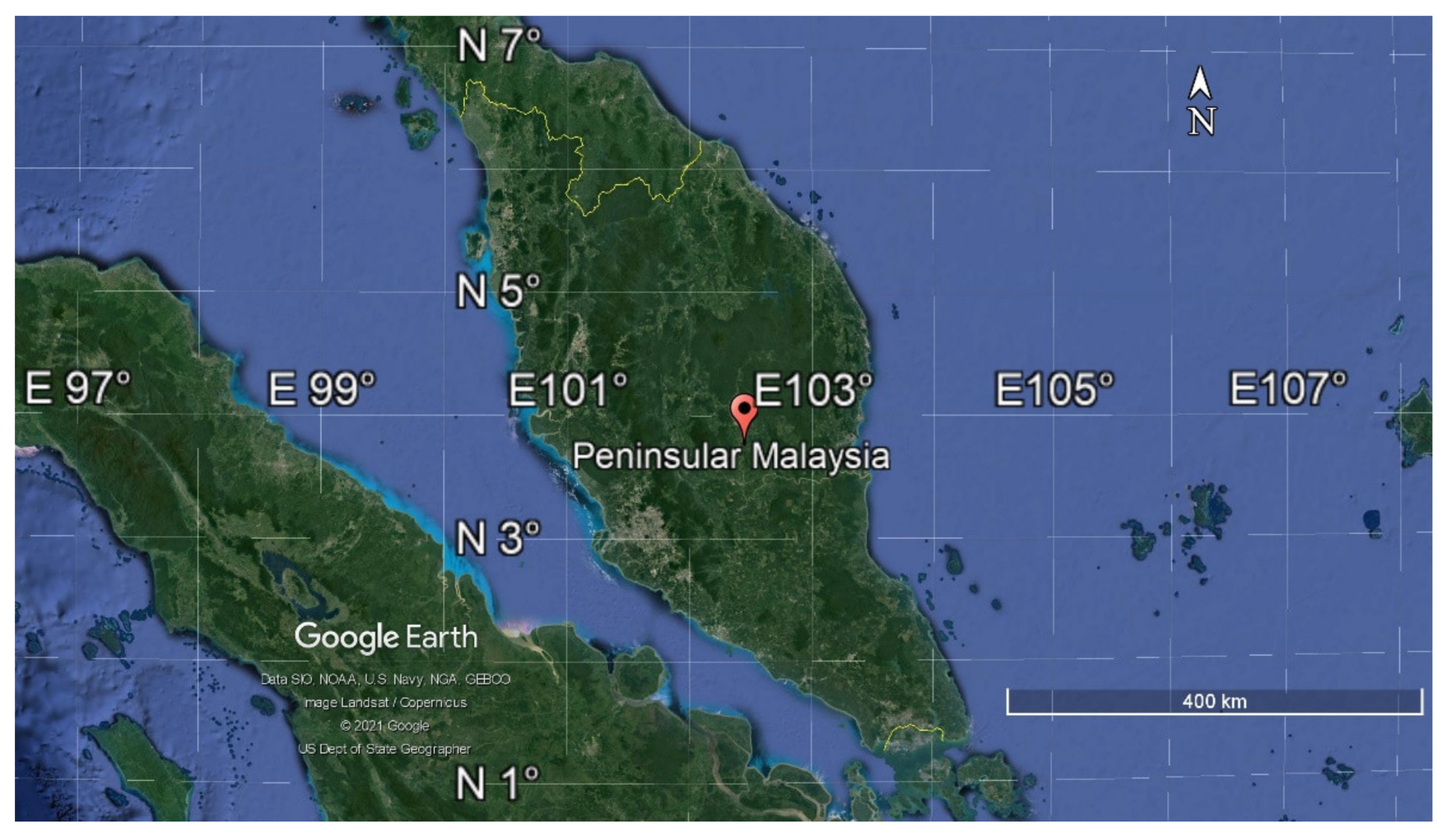

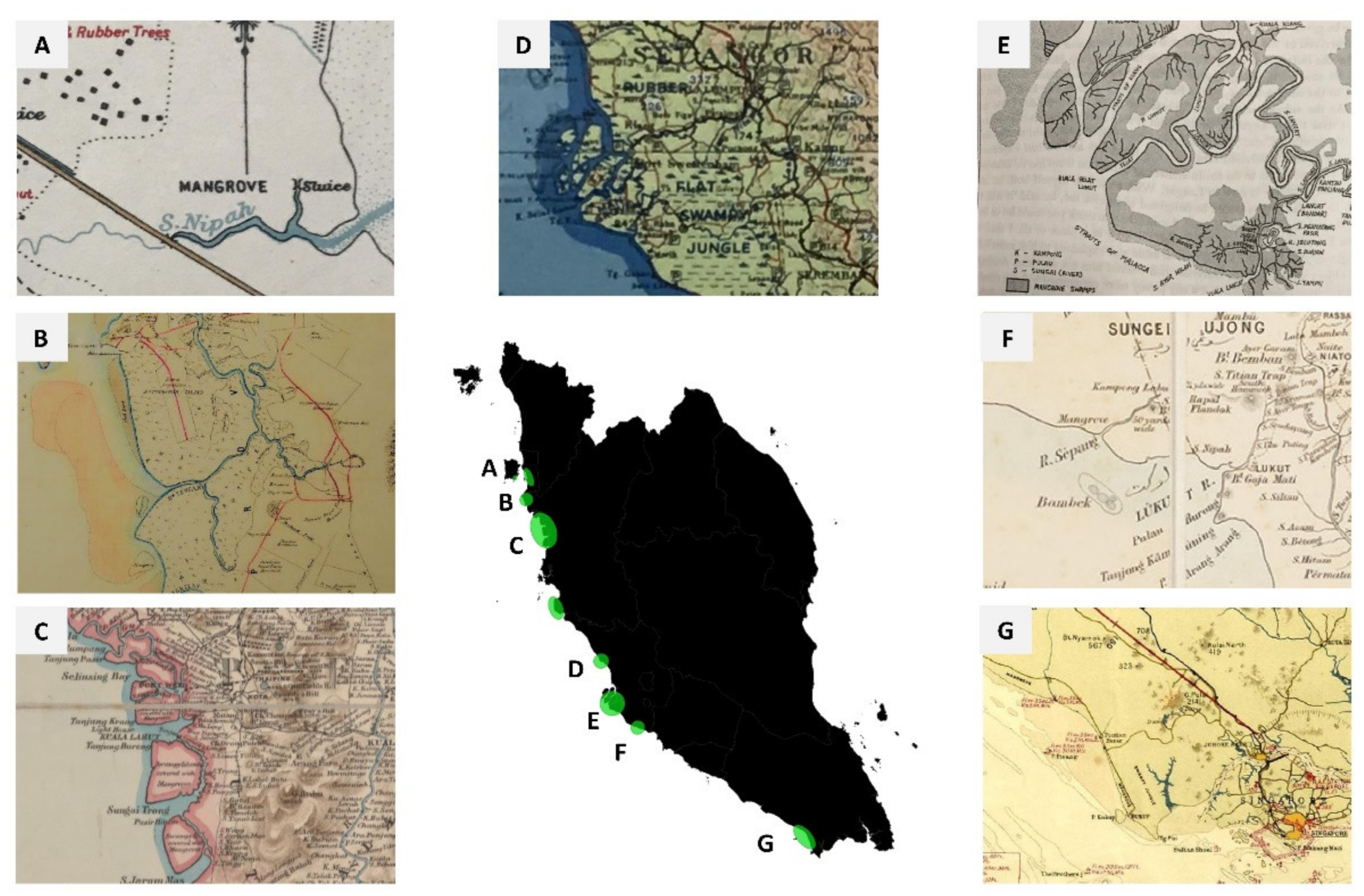
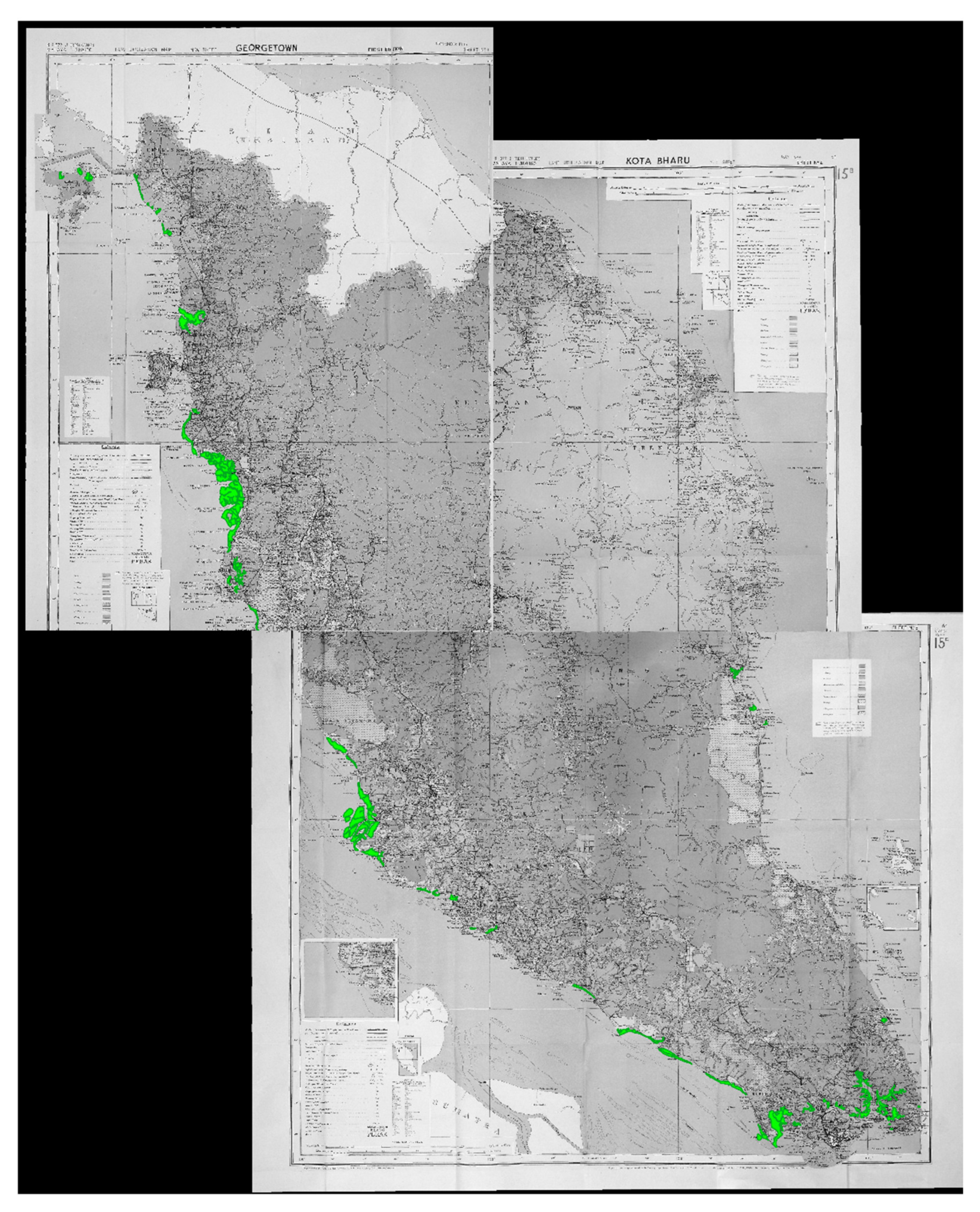
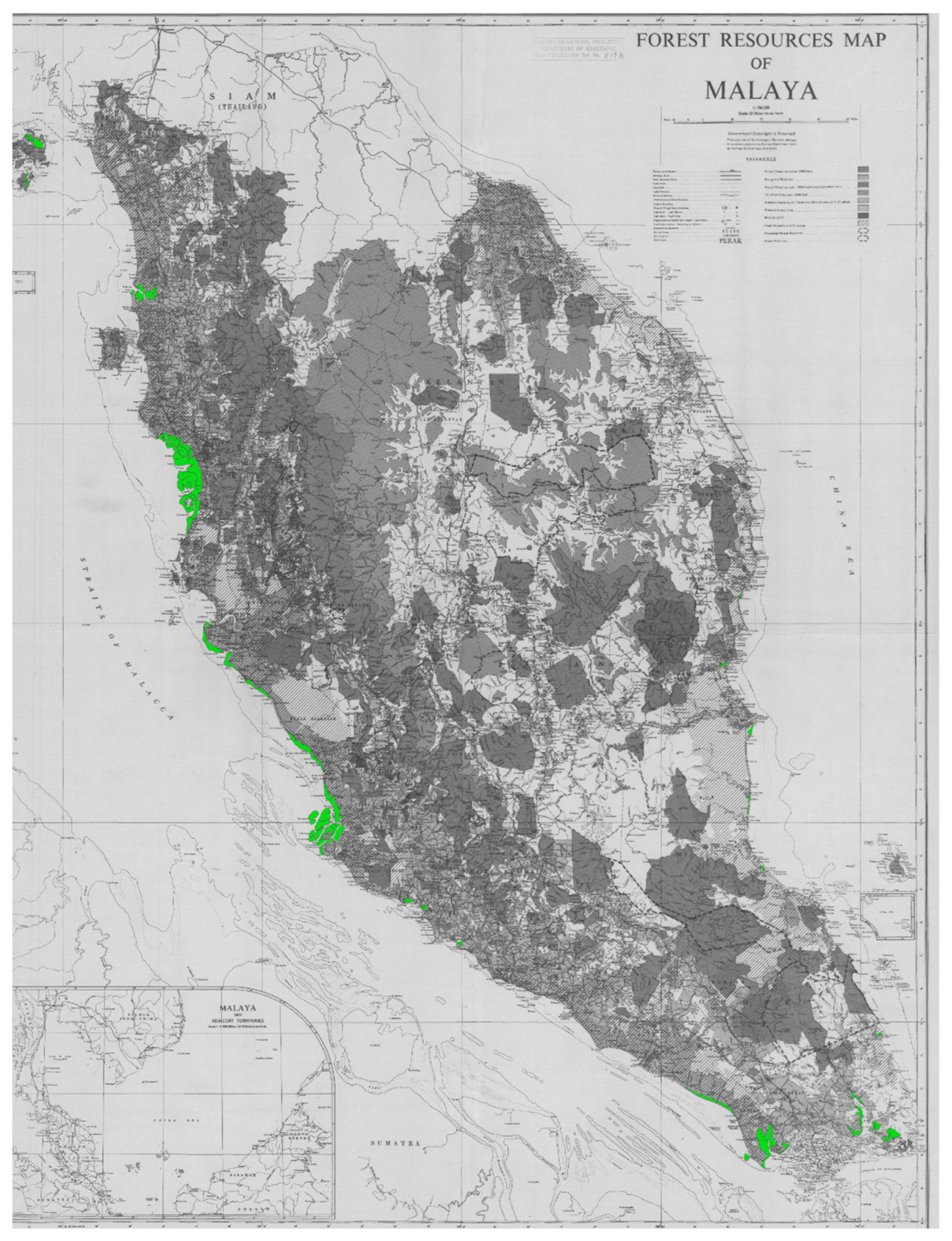
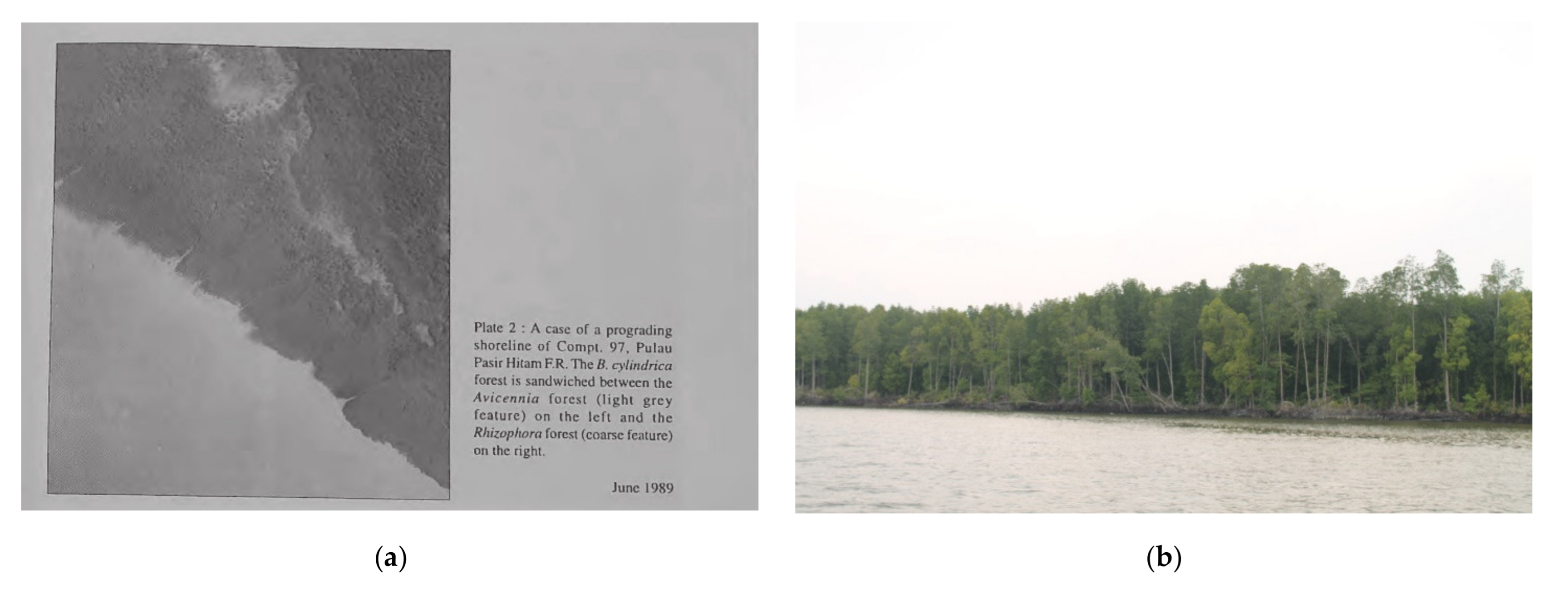


| Archive | Online Catalogue |
|---|---|
| The National Archives, United Kingdom | https://discovery.nationalarchives.gov.uk (Accessed on 4–31 December 2018) |
| Nationaal Archief, Netherlands | https://www.nationaalarchief.nl/en/research (Accessed on 15–31 December 2018) |
| National Archives of Malaysia (Arkib Negara), Malaysia | http://compassweb.arkib.gov.my/english, (Accessed on 1–31 January 2019) |
| National Archives of Singapore, Singapore | http://www.nas.gov.sg/archivesonline, (Accessed on 13–31 January 2019) |
| Sensor | Landsat Satellite | Bands | Wavelength (μm) | Resolution (m) |
|---|---|---|---|---|
| Multispectral Scanner (MSS) | Landsat 1, 2, 3 | Band 4—Green | 0.5–0.6 | 60 |
| Band 5—Red | 0.6–0.7 | 60 | ||
| Band 6—Near Infrared | 0.7–0.8 | 60 | ||
| Band 7—Near Infrared | 0.8–1.1 | 60 | ||
| Landsat 4, 5 | Band 1—Green | 0.5–0.6 | 60 | |
| Band 2—Red | 0.6–0.7 | 60 | ||
| Band 3—Near Infrared | 0.7–0.8 | 60 | ||
| Band 4—Near Infrared | 0.8–1.1 | 60 | ||
| Thematic Mapper (TM) | Landsat 4, 5 | Band 1—Blue | 0.45–0.52 | 30 |
| Band 2—Green | 0.52–0.60 | 30 | ||
| Band 3—Red | 0.63–0.69 | 30 | ||
| Band 4—Near Infrared | 0.76–0.90 | 30 | ||
| Band 5—Short-wave Infrared | 1.55–1.75 | 30 | ||
| Band 6—Thermal Infrared | 10.40–12.50 | 30 | ||
| Band 7—Short-wave Infrared | 2.08–2.35 | 30 | ||
| Enhanced Thematic Mapper Plus (ETM+) | Landsat 7 | Band 1—Blue | 0.45–0.52 | 30 |
| Band 2—Green | 0.52–0.60 | 30 | ||
| Band 3—Red | 0.63–0.69 | 30 | ||
| Band 4—Near Infrared | 0.77–0.90 | 30 | ||
| Band 5—Short-wave Infrared | 1.55–1.75 | 30 | ||
| Band 6—Thermal Infrared | 10.40–12.50 | 60 | ||
| Band 7—Short-wave Infrared | 2.09–2.35 | 30 | ||
| Band 8—Panchromatic | 0.52–0.90 | 30 | ||
| Operational Land Imager (OLI)/ Thermal Infrared Sensor (TIRS) | Landsat 8 | Band 1—Coastal aerosol | 0.43–0.45 | 30 |
| Band 2—Blue | 0.45–0.51 | 30 | ||
| Band 3—Green | 0.53–0.59 | 30 | ||
| Band 4—Red | 0.64–0.67 | 30 | ||
| Band 5—Near Infrared | 0.85–0.88 | 30 | ||
| Band 6—Short-wave Infrared 1 | 1.57–1.65 | 30 | ||
| Band 7—Short-wave Infrared 2 | 2.11–2.29 | 30 | ||
| Band 8—Panchromatic | 0.50–0.68 | 15 | ||
| Band 9—Cirrus | 1.36–1.38 | 30 | ||
| Band 10—TIRS 1 | 10.60–11.19 | 100 | ||
| Band 11—TIRS 2 | 11.50–12.51 | 100 |
| Year | Classified Map | Reference Data (GCPs) | Total | Producer’s Accuracy | User’s Accuracy | |
|---|---|---|---|---|---|---|
| Mangrove | Non-Mangrove | |||||
| 1988 | Mangrove | 57 | 8 | 65 | 76.000 | 87.692 |
| Non-mangrove | 18 | 160 | 178 | 95.238 | 89.888 | |
| Total | 75 | 168 | 243 | |||
| Total accuracy | 89.30 | |||||
| Kappa coefficient | 0.740 | |||||
| 1992 | Mangrove | 59 | 11 | 70 | 79.730 | 84.286 |
| Non-mangrove | 15 | 157 | 172 | 93.452 | 91.279 | |
| Total | 74 | 168 | 242 | |||
| Total accuracy | 89.256 | |||||
| Kappa coefficient | 0.743 | |||||
| 2002 | Mangrove | 70 | 4 | 74 | 93.333 | 94.595 |
| Non-mangrove | 5 | 161 | 166 | 97.576 | 96.988 | |
| Total | 75 | 165 | 240 | |||
| Total accuracy | 96.250 | |||||
| Kappa coefficient | 0.912 | |||||
| 2012 | Mangrove | 57 | 3 | 60 | 76.000 | 95.000 |
| Non-mangrove | 18 | 163 | 181 | 98.193 | 90.055 | |
| Total | 75 | 166 | 241 | |||
| Total accuracy | 91.286 | |||||
| Kappa coefficient | 0.785 | |||||
| 2018 | Mangrove | 68 | 18 | 86 | 90.667 | 79.070 |
| Non-mangrove | 7 | 337 | 344 | 94.930 | 97.965 | |
| Total | 75 | 355 | 430 | |||
| Total accuracy | 94.186 | |||||
| Kappa coefficient | 0.809 | |||||
Publisher’s Note: MDPI stays neutral with regard to jurisdictional claims in published maps and institutional affiliations. |
© 2021 by the authors. Licensee MDPI, Basel, Switzerland. This article is an open access article distributed under the terms and conditions of the Creative Commons Attribution (CC BY) license (https://creativecommons.org/licenses/by/4.0/).
Share and Cite
Gopalakrishnan, L.; Satyanarayana, B.; Chen, D.; Wolswijk, G.; Amir, A.A.; Vandegehuchte, M.B.; Muslim, A.B.; Koedam, N.; Dahdouh-Guebas, F. Using Historical Archives and Landsat Imagery to Explore Changes in the Mangrove Cover of Peninsular Malaysia between 1853 and 2018. Remote Sens. 2021, 13, 3403. https://doi.org/10.3390/rs13173403
Gopalakrishnan L, Satyanarayana B, Chen D, Wolswijk G, Amir AA, Vandegehuchte MB, Muslim AB, Koedam N, Dahdouh-Guebas F. Using Historical Archives and Landsat Imagery to Explore Changes in the Mangrove Cover of Peninsular Malaysia between 1853 and 2018. Remote Sensing. 2021; 13(17):3403. https://doi.org/10.3390/rs13173403
Chicago/Turabian StyleGopalakrishnan, Lavaniadevi, Behara Satyanarayana, Danyang Chen, Giovanna Wolswijk, A. Aldrie Amir, Michiel B. Vandegehuchte, Aidy B. Muslim, Nico Koedam, and Farid Dahdouh-Guebas. 2021. "Using Historical Archives and Landsat Imagery to Explore Changes in the Mangrove Cover of Peninsular Malaysia between 1853 and 2018" Remote Sensing 13, no. 17: 3403. https://doi.org/10.3390/rs13173403







